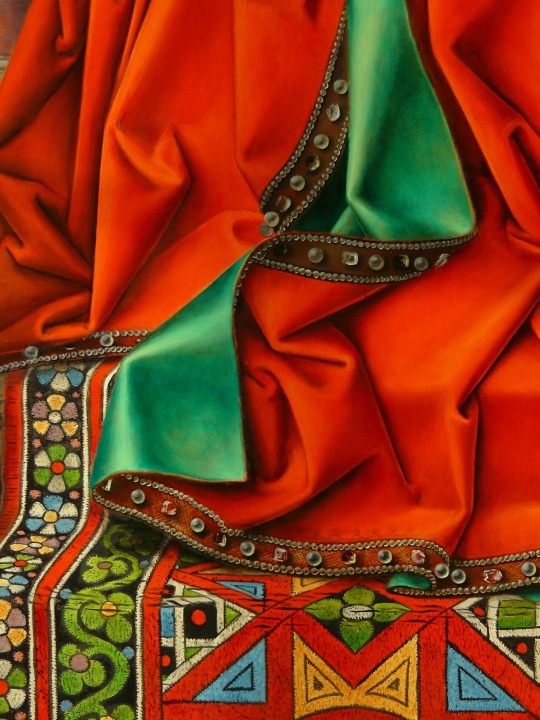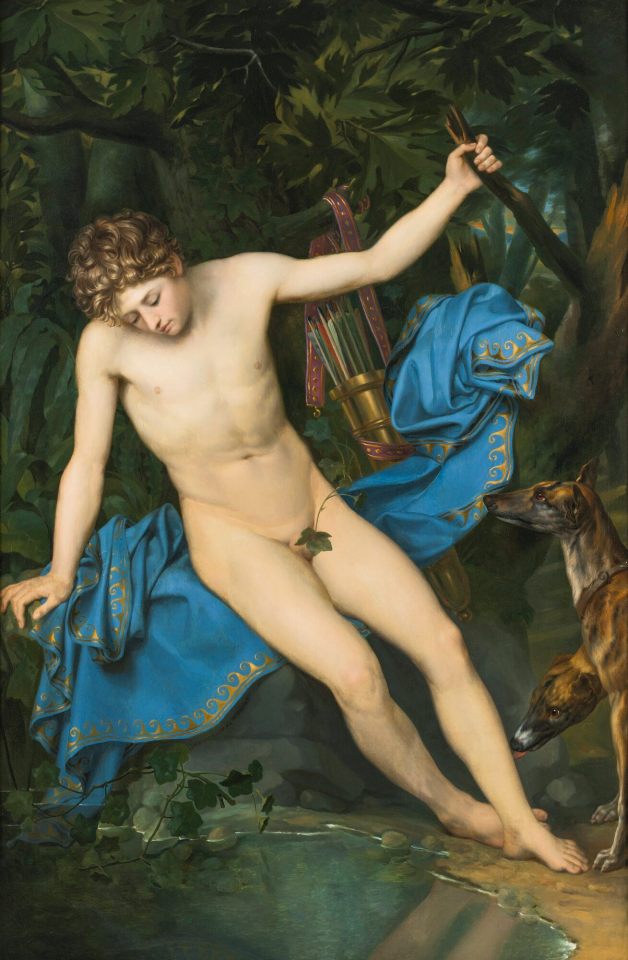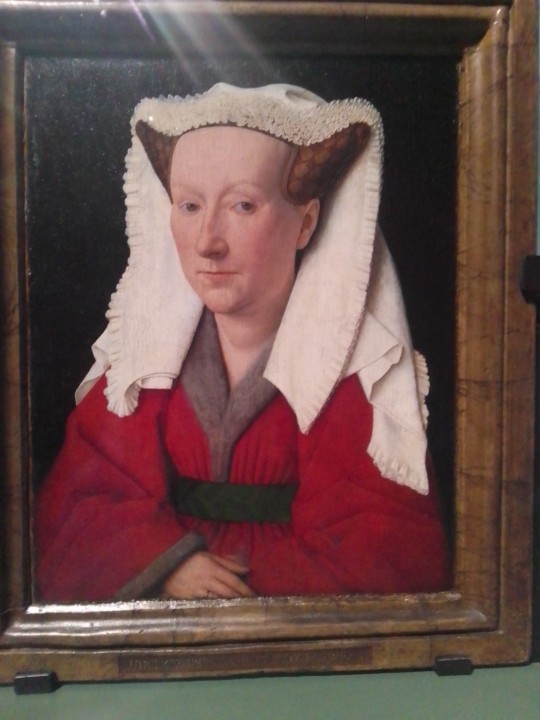#Groeningemuseum
Explore tagged Tumblr posts
Text

Jan van Eyck (Be. 1390-1441)
Detail from the Van der Paele Madonna (1436)
Oil on panel (122 x 158 cm)
306 notes
·
View notes
Text

~1820, Joseph-Denis Odevaere, Narcisse
122 notes
·
View notes
Text

Portrait of a woman with her two children
Circa 1804, Napoleonic era, by François-Joseph Kinson
This family portrait is very interesting because it illustrates the fashion of Napoleon’s time. The mother wears a velvet dress with the characteristic high waist and puffed sleeves. Her dark blue dress with a short corsage is set with decorations inspired by military uniforms. Kinson very carefully painted these brandebourgs of gold thread and the matching knotted string with two tassels. The daughter is portrayed in a fashionable white silk dress finished with a fur strip. Her updo is very similar to her mother’s: with a parting in the middle, a chignon at the back of the head and graceful ringlets along the temples. Her brother is depicted in a dark-colored suit with a white shirt underneath with a stand-up collar. The luxurious red cashmere scarf on the velvet upholstered sofa completes the empire portrait.
(Musea Brugge)
#François-Joseph Kinson#Kinson#François Kinson#Franciscus Josephus Kinsoen#Kinsoen#Flemish art#French art#art#napoleonic era#napoleonic#painting#Groeningemuseum#Groeninge museum#Belgium#Belgian art
39 notes
·
View notes
Photo







details of ‘Last Judgement’ by Pieter Pourbus- Groeninge Museum, Bruges
#pieter pourbus#last judgement#devil#demon#hell#satan#lucifer#folkhorror#painting#wall art#art history#history#bruges#museum#groeningemuseum#nun#skeleten#memento mori#skulls#gothic#goth#creepy#macabre#morbid#sinner#sin#punishment
202 notes
·
View notes
Text

Fernand Knopff- Secret-Reflection, pastel and crayon on paper , Groeningemuseum, Bruges , Image Source
29 notes
·
View notes
Text

Joseph François Ducq, 1762-1829
Vénus introduisant Pâris dans l’appartement d’Hélène à Sparte, 1806, oil on canvas, 63x48 cm
Groeningemuseum de Bruges
27 notes
·
View notes
Text

Milo of Croton
Artist: Joseph-Benoît Suvée (Flemish, 1743–1807)
Date: 1763
Medium: Oil on canvas
Collection: Groeningemuseum, Bruges, Belgium
Milo of Croton
Milo or Milon of Croton (late 6th century BC) was a famous ancient Greek athlete from the Greek colony of Croton in Magna Graecia.
He was a six-time Olympic victor; once for boys wrestling in 540 BC at the 60th Olympics, and five-time wrestling champion at the 62nd through 66th Olympiads. Milo kept on competing, even well after what would have been considered a normal Olympic athlete's prime; by the 67th Olympiad, he would have been over 40 years of age. He also attended many of the Pythian Games.
His historicity is attested by many classical authors, among them Aristotle, Pausanias, Cicero, Herodotus, Vitruvius, Epictetus, and the author of the Suda, but there are many legendary stories surrounding him.
Diodorus Siculus wrote in his history that Milo was a follower of Pythagoras and also that he commanded the Crotonian army which defeated the Sybarites in 511 BC, while wearing his Olympic wreaths and dressed like Hercules in a lion's skin and carrying a club.
Hereupon the Sybarites took the field with an army of three hundred thousand men. The Crotonians had but an hundred thousand, which were commanded by Milo the wrestler, who at the first onset put to flight that wing of the army which was opposite to him: for he was of invincible strength, and had courage answerable to his strength, and had been six times victor at the olympic games; when he began his fight, he was crowned with olympic wreaths, wearing (like Hercules) a lion's skin and a club; at last he gained an absolute victory, and thereupon was much admired by his countrymen.
Milo's death became a popular subject in art in late Italian Renaissance sculpture, continuing to around 1900, allowing the sculptor to show his skill in a dramatic anatomical pose. It was a more compact equivalent of the Roman group of Laocoön and His Sons.
#painting#oil on canvas#ancient#greek athete#flemish painter#18th century painting#joseph benoit suvee#european art#milo of croton#magna grecia#wresting#champion#history#pythian games#beats
9 notes
·
View notes
Text

Gertrude Cornélie Marie de Pélichy - Caritas Romana -
oil on canvas, height: 118.6 cm (46.6 in) Edit this at Wikidata; width: 99.3 cm (39 in)
Groeningemuseum, Bruges, Belgium
Gertrude Cornélie Marie de Pélichy (1743 – 1825) was a painter from the Northern Netherlands active in Paris and Bruges.
24 notes
·
View notes
Text

Gerard David, The Judgement of Cambyses (detail), 1498. Oil on wood, 202 cm × 349.5 cm. Groeningemuseum, Bruges.
27 notes
·
View notes
Text
Firmin Baes
Belgian, 1874–1943
The Cleaning Woman
1910
Pastel
Groeningemuseum, Bruges, Belgium

7 notes
·
View notes
Text

Jacob de Backer - The Garden of Eden (c. 1575 - 1600), Groeningemuseum
8 notes
·
View notes
Photo

Zelfportret - circa 1858 - Groeningemuseum
11 notes
·
View notes
Photo


‘Death and the Miser’ Jan Provoost- Groeningemuseum, Bruges Belgium
#groeningemuseum#museum#death#dead#memento mori#corpse#skeleton#skull#skulls#painting#wall art#art#art history#goth#gothic#macabre#morbid#horror#folklore#folk horror
34 notes
·
View notes
Text

Samedi 10 juin 2023 - Une deuxième visite au Groeningemuseum
2 notes
·
View notes
Text

The Naked Warrior. Augustin van den Berghe (1756 – 1836), was a painter born in the Austrian Netherlands. This work dates to between 1780 and 1790 and is housed at The Groeningemuseum, a municipal museum in Bruges, Belgium, built on the site of the medieval Eekhout Abbey.
Notebook available in our shop.
0 notes
Text


In the Groeningemuseum today I saw some of the paintings I was reading about yesterday including these two famous portraits from the 15th century. On the left is Philip the Good, Duke of Burgundy,* painted by Rogier van der Weyden, and on the right is the portrait of the artist Jan van Eyck's wife, Margareta van Eyck. Also there was the work of Hans Memling, Petrus Christus, Master of the Legend of Saint Ursula, Jan Provoost and Gerard David. And I picked up these tidbits of information:
In the 16th century, Bruges produced two artististic dynasties that remained active until well into the 17th century: the Claeissens and the Blondeel-Pourbus families. The Claeissens continued to dominate the Bruges art market with allegorical compositions whose meaning is sometimes hard to decipher. Pieter Pourbus trained both his son Frans and grandson Frans II, the latter of whom painted the official portraits of the Archdukes Albert and Isabella.
*For context, Brussels became the capital of the French duchy of Burgundy in the 1430s. CHECK - MORE READING ON THIS TOPIC IS REQUIRED!!!

0 notes